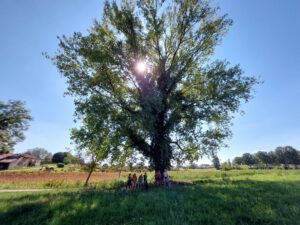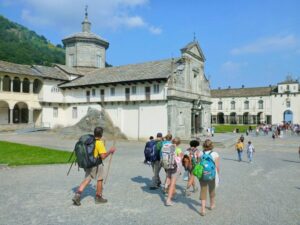Il Cammino di Oropa Inclusivo
Crediamo che l’esperienza del Cammino debba essere estesa a più persone possibili. Per questo motivo quando abbiamo progettato l’itinerario del Cammino di Oropa della Serra rivolgendo particolare attenzione alle persone con disabilità, senza trascurare però anche altre categorie di persone con esigenze specifiche, ad esempio chi viaggia con il proprio cane oppure chi viaggia insieme ai propri bambini.
Qui vi diamo qualche indicazione e raccomandazione generale, ma è sempre importante nella progettazione di un viaggio tenere conto delle esigenze specifiche del singolo viaggiatore, non generalizzandone i bisogni.
Pellegrini ipovedenti o ciechi
L’itinerario è stato studiato con una particolare attenzione per le persone con ipovedenti o cieche. Non ci sono tratti su strade trafficate, abbiamo privilegiato carrarecce e strade che consentano a due persone di camminare appaiate, e abbiamo cercato di evitare tratti esposti, o con sassi e radici che rendessero difficoltoso il cammino.
Inoltre su tutto il Cammino abbiamo applicato segnavia gialli e neri poiché questi colori sono i più indicati per esser visti dalle persone ipovedenti.
Le persone cieche o ipovedenti possono comunque percorrere l’itinerario solo se accompagnate.
Nel 2018 l’Associazione Movimento Lento ha collaudato il Cammino di Oropa insieme a Giglia Oblach e Luca Casella, due persone cieche. L’esperienza è stata molto utile per revisionare il percorso per renderlo più accessibile per persone cieche o ipovedenti.
Nel 2019 l’Associazione Movimento Lento ha organizzato il Cammino di Oropa con un gruppo di persone vedenti, ipovedenti e non vedenti che hanno camminato insieme guidandosi a vicenda.
Pellegrini con mobilità ridotta
Per le persone con mobilità ridotta che hanno bisogno di utilizzare la carrozzina, il percorso del Cammino di Oropa della Serra pedonale non è fattibile dal momento che si tratta di un percorso a tratti molto sconnesso. L’itinerario della Ciclovia della Serra può invece essere affrontato da carrozzine con trazione elettrica adatte al fuoristrada e possibilmente con trazione posteriore, perché date le pendenze, in alcuni casi superiori al 10%, le altre carrozzine potrebbero non essere adeguate.
Invece il percorso pedonale può essere percorso da persone con disabilità motoria che utilizzano la Joelette, facendo attenzione a prendere nell’ultima tappa la variante della tramvia ed evitando il sentiero D1.
Per quanto riguarda invece le persone affette da disabilità cognitiva, se accompagnate, non incontreranno problemi lungo il Cammino poiché l’itinerario non prevede tratti particolarmente esposti o lungo strade trafficate.
Compila questo modulo, le ragazze del Centro Prenotazioni ti indicheranno le strutture adatte alle tue esigenze.
Pellegrini con cani
Coloro che decidono di intraprendere il Cammino di Oropa con il proprio cane potranno trovare in ogni tappa una o più strutture di accoglienza dog friendly. Le tappe sono brevi e per la maggior parte del percorso si cammina all’ombra su fondo sterrato evitando quindi il problema della bruciatura dei polpastrelli dei nostri amici a 4 zampe.
Se i cani sono educati ed obbedienti è possibile lasciarli liberi per lunghi tratti, tuttavia è sempre bene legarli sia in prossimità di stalle e alpeggi, per evitare di spaventare gli animali sia nei tratti boschivi, specialmente se il cane ha un forte istinto alla caccia, poiché sono presenti vari animali selvatici.

Il cammino per le famiglie
Le famiglie con bambini che decidono di intraprendere il Cammino di Oropa della Serra sono in aumento.
Prima di intraprendere qualsiasi tipo di cammino con bambini di ogni età è bene fare una precisazione: l’esito dell’esperienza dipenderà dall’allenamento e dall’abitudine al cammino che hanno i bambini, quindi consigliamo a tutti i genitori di approcciare il cammino per gradi e con allenamento.
Si tratta di un percorso sicuro in cui non sono presenti tratti particolarmente pericolosi o esposti. Per quanto riguarda la mobilità con il passeggino, con un passeggino da trekking è possibile percorrere tranquillamente tutta la prima e la seconda tappa e parte della terza tappa fino al Laghetto Cossavella. In quel punto si incrocia il tracciato della Ciclovia della Serra e consigliamo di portarsi sul percorso ciclabile e percorrere il Tracciolino per arrivare ad Oropa.
“Non vediamo l’ora di intraprendere questo viaggio perché ogni volta che ci mettiamo in cammino scopriamo le meraviglie del territorio, sotto tutti gli aspetti: naturalistico, gastronomico, storico. Con tutti i sensi.
Al contempo la nostra storia incuriosisce le comunità locali, le strutture ricettive, gli altri pellegrini. Siamo una testimonianza itinerante che permette a chi non conosce l’ipovisione di imparare quali sono le potenzialità oltre le inevitabili difficoltà nel nostro quotidiano.
Il Cammino di Oropa è adatto a chi desidera scoprire un territorio in modo lento, immersi nel verde e nel ritmo dei passi.”
Ogni anno Noisy Vision organizza viaggi con persone cieche e ipovedenti lungo il Cammino di Oropa, la Via degli Dei e altri cammini italiani.
“Non vediamo l’ora di intraprendere questo viaggio perché ogni volta che ci mettiamo in cammino scopriamo le meraviglie del territorio, sotto tutti gli aspetti: naturalistico, gastronomico, storico. Con tutti i sensi.
Al contempo la nostra storia incuriosisce le comunità locali, le strutture ricettive, gli altri pellegrini. Siamo una testimonianza itinerante che permette a chi non conosce l’ipovisione di imparare quali sono le potenzialità oltre le inevitabili difficoltà nel nostro quotidiano.
Il Cammino di Oropa è adatto a chi desidera scoprire un territorio in modo lento, immersi nel verde e nel ritmo dei passi.”
Ogni anno Noisy Vision organizza viaggi con persone cieche e ipovedenti lungo il Cammino di Oropa, la Via degli Dei e altri cammini italiani.

 Il nostro procedere è lento, ma consapevole.
Il nostro procedere è lento, ma consapevole. Siamo una cooperativa sociale-tour operator, una rete di soggetti e associazioni in Italia e nel mondo. La nostra storia è iniziata alla fine degli anni ’90, quando un manipolo di persone ha iniziato ad interrogarsi sul senso del turismo di massa. Viaggiando e conoscendo progetti legati al commercio equo solidale è nata l’idea di far nascere un’impresa sociale che si occupasse di stravolgere i paradigmi del turismo e lavorare a contatto diretto con la società civile dei luoghi visitati, con persone ed associazioni direttamente coinvolte in progetti di sviluppo.
Siamo una cooperativa sociale-tour operator, una rete di soggetti e associazioni in Italia e nel mondo. La nostra storia è iniziata alla fine degli anni ’90, quando un manipolo di persone ha iniziato ad interrogarsi sul senso del turismo di massa. Viaggiando e conoscendo progetti legati al commercio equo solidale è nata l’idea di far nascere un’impresa sociale che si occupasse di stravolgere i paradigmi del turismo e lavorare a contatto diretto con la società civile dei luoghi visitati, con persone ed associazioni direttamente coinvolte in progetti di sviluppo.